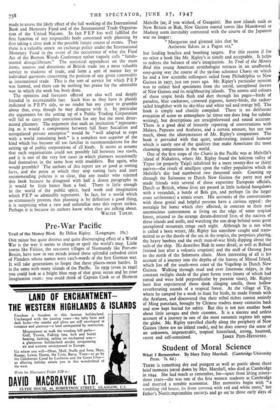Pre-War Pacific
Trail of the Money Bird. By Dillon Ripley. (Longmps. 15s.)
ONE minor but quite distinct and quite discouraging effect of a World War is the way it seems to change or spoil the world's map. Little towns like Falaise, the sea-coast villages of Normandy like Port-en- Bessin, have now in our minds joined those splendid cathedral cities of Flanders whose names were catch-words of the first German war. It will take generations to forget that these places.-mean battles. It is the same with many islands of the Pacific. In 1939 (even in 1940) you could look at a bright blue map of that great ocean and let.your imagination roam : you could think of Captain Cook or of Herman Melville (or, if you wished, of Gauguin). But now islands such as New Britain or Biak, New Guinea coastal towns like Manokwari or Madang seem inevitably connected with the course of the Japanese war no longer:
"Marquesas and glenned isles that be Authentic Edens in a Pagan sea," but landing beaches and bombing targets. For this reason if for ' no other a book like Mr. Ripley's is timely and acceptable. It helps to redress the balance of one's imagination. In Trail of the Money Bird this young American ornithologist retraces in an unaffected, easy-going way the course of the 59-foot schooner Charis on which he and a few scientific colleagues sailed from Philadelphia to New Guinea in 1937, just ten years ago. Mr. Ripley's particular mission was to collect bird specimens from the torrid, unexplored forests of New Guinea and its neighbouring islands. The names and colours of these tropic birds flash and dart through his pages—birds of paradise, blue cockatoos, crowned pigeons, honey-birds, the racket- tailed kingfisher with its sky-blue and white tail and orange bill. The book is simply and chattily compiled. There is no deliberate evocation of scene or atmosphere (at times one does long for subtler writing), but descriptions are straightforward and sound accurate.
There is a good deal of leisurely reporting of conversations with
Malays, Papuans and Arafuras, and a certain amount, but not too much, about the idiosyncrasies of Mr. Ripley's companions. The
book is pervaded with that quiet, understating, ironical humour which is surely one of the qualities that make Americans the most charming companions in the world.
One of the first stops of the Charis in the Pacific was at Melville's island of Nukahiva, where Mr. Ripley found the halcyon valley of Typee (or properly Taipi) inhabited by a mere twenty-five or thirty
natives—the result of smallpox upon the valley population which in Melville's day had numbered two thousand souls. Coasting up through the Soiomons to Dutch New Guinea the party met and made friends with several of those expatriate European officials, Dutch or British, whose lives are passed in little isolated bungalows with a verandah, a bottle of Bois gin, and perhaps (in the larger coast settlements) a tennis court. His accounts of the conversations with these genial and helpful persons have a curious appeal: the nostalgia for home which they affectedi in contrast to their real unconscious contentment at living on the edge of some tropical forest, attuned to the strange dream-directed lives of the natives of these islands and atolls, and watching the sun drop behind some great unexplored mountain range each night. Although he is not what is called a born writer, Mr. Ripley has somehow caught and trans- mitted to us thedazzle of the sea in the tropics, the porpoises playing, the heavy boobies and the swift man-of-war birds dipping about the sails of the ship. He describes Biak in some detail, as well as Rabaul (visited just after a volcanic eruption) and the atoll of Ontong Java to the north of the Solcenons chain. Most interesting of all is his account of a journey into the depths of the forests of Misool Island, which lies off the south-west coast of the Vogelkop in Dutch New Guinea. Walking through mud and over limestone ridges, in the constant twilight shade of the giant forest trees (many of which had rotted and were held perpendicular by parasite vines), Mr. Ripley here first experienced those dank clinging smells, those hollow reverberating sounds of a tropical forest. At the village of Tip, where he camped for a week to hunt for birds, he made friends with the Arafuras, and discovered that their tribal riches consist entirely of Ming porcelain, brought by Chinese traders many centuries back and now kept buried for safety. But this is not just another book about little savages and their customs. It is a sincere and artless account of a journey in one of the most romantic regions left upon the globe. Mr. Ripley travelled chiefly along the periphery of New Guinea (there are no inland roads), and he does convey the sense of an unknown, impenetrable, tropical hinterland, strong, haunted,


































 Previous page
Previous page